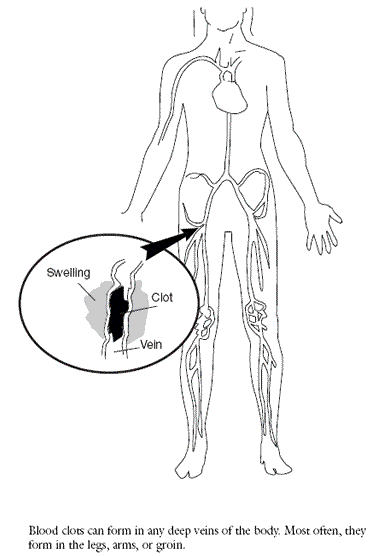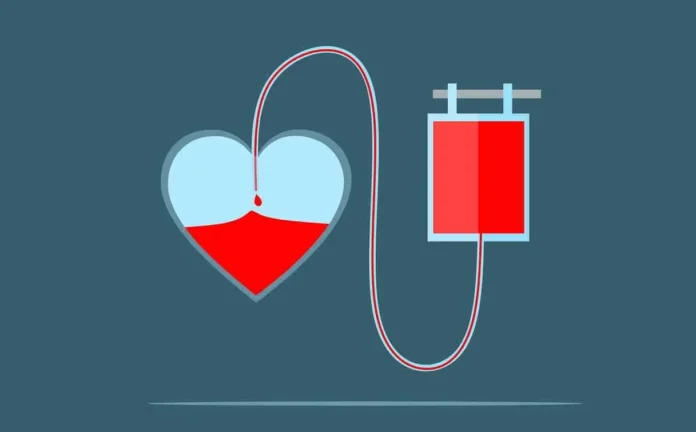Last Updated on January 14, 2024 by The Health Master
Blood clots: Preventing & Treating
Blood clots are a serious medical condition. It is important to know the signs and get treated right away.
This guide describes ways to prevent and treat blood clots; symptoms; and medication side effects as well as when to go to the emergency room.
This guide was funded by the Agency for Healthcare Research and Quality (AHRQ) under grant No. U18 HS015898-01.
Introduction
Blood clots (also called deep vein thrombosis [throm-BO-sis]) most often occur in people who can’t move around well or who have had recent surgery or an injury. Blood clots are serious. It is important to know the signs and get treated right away. This guide tells about ways to prevent and treat blood clots. Figure 1 provides an illustration of a blood clot in the leg.
In this guide, the term “doctor” is used. It can mean doctor, nurse, physician’s assistant, nurse practitioner, pharmacist, or other heath care professional.
Causes of Blood Clots
Blood clots can form if you don’t move around a lot. You may also get a blood clot if you:
- Have had recent surgery.
- Are 65 or older.
- Take hormones, especially for birth control. (Ask your doctor about this).
- Have had cancer or are being treated for it.
- Have broken a bone (hip, pelvis, or leg).
- Have a bad bump or bruise.
- Are obese.
- Are confined to bed or a chair much of the time.
- Have had a stroke or are paralyzed.
- Have a special port the doctor put in your body to give you medicine.
- Have varicose (VAR-e-kos) or bad veins.
- Have heart trouble.
- Have had a blood clot before.
- Have a family member who has had a blood clot.
- Have taken a long trip (more than an hour) in a car, airplane, bus, or train.
| Are you at risk? Some people are more likely to get blood clots. Talk with your doctor to see if you are at risk. |
Read more articles on blood, click here
Symptoms of a Blood Clot
You may have a blood clot if you see or feel:
- New swelling in your arm or leg.
- Skin redness.
- Soreness or pain in your arm or leg.
- A warm spot on your leg.
| Important! If you think you have a blood clot, call your doctor or go to the emergency room right away! |
Blood clots can be dangerous. Blood clots that form in the veins in your legs, arms, and groin can break loose and move to other parts of your body, including your lungs.
A blood clot in your lungs is called a pulmonary embolism (POOL-mo-nar-e EM-bo-liz-em). If this happens, your life can be in danger. Go to the emergency room or call 911.
A blood clot may have gone to your lungs if you suddenly have:
- A hard time breathing.
- Chest pain.
- A fast heartbeat.
- Fainting spells.
- A mild fever.
- A cough, with or without blood.
Preventing Blood Clots
You can help prevent blood clots if you:
- Wear loose-fitting clothes, socks, or stockings.
- Raise your legs 6 inches above your heart from time to time.
- Wear special stockings (called compression stockings) if your doctor prescribes them.
- Do exercises your doctor gives you.
- Change your position often, especially during a long trip.
- Do not stand or sit for more than 1 hour at a time.
- Eat less salt.
- Try not to bump or hurt your legs and try not to cross them.
- Do not use pillows under your knees.
- Raise the bottom of your bed 4 to 6 inches with blocks or books.
- Take all medicines the doctor prescribes you.
| Stay active! Staying active and moving around may help prevent blood clots. |
Treatment for Blood Clots
If you have been told you have a blood clot, your doctor may give you medicine to treat it. This type of medicine is called a blood thinner (also called an anticoagulant [an-te-ko-AG-u-lent]). In most cases, your doctor will tell you to follow this treatment plan:
- For the first week you will receive medicine called heparin (HEP-a-rin) that works quickly.
- This medicine is injected under the skin. You will learn how to give yourself these shots, or a family member or friend may do it for you.
- You will also start taking Coumadin® (COO-ma-din)—generic name: warfarin (WAR-far-in)—pills by mouth. After about a week of taking both the shots and the pills, you will stop taking the shots. You will continue to take the Coumadin®/warfarin pills for about 3 to 6 months or longer.
Side Effects of Blood Thinners
Blood thinners can cause side effects. Bleeding is the most common problem. Your doctor will watch you closely. If you notice something wrong that you think may be caused by your medication, call your doctor.
| Are you bleeding too much? If you think you are bleeding too much, call your doctor or go to the nearest emergency room. Tell them you are being treated for blood clots. Tell them the medicines you are taking. |
List of Terms
| Term | Meaning |
|---|---|
| Anticoagulant | Medicine that thins your blood |
| Blood clot | Blood that clumps together |
| Blood thinner | Another name for medicine that prevents blood from clotting |
| Coumadin®/warfarin, heparin | Types of medicines that keep blood from clotting |
| Deep vein thrombosis | A blood clot that forms in the veins of the legs, arms, or groin |
| Pulmonary embolism | A blood clot that has traveled to your lungs |
| Varicose veins | Enlarged veins, often found in your legs |
Figure 1: Illustration of a Blood Clot

Text Description
This figure is a drawing of a human body with the heart and veins shown in the abdominal area and down to the legs. There is a large oval with an arrow pointing to a vein in the groin area. Within the oval is an illustration showing a close-up of a blood clot in the vein and the swelling in the area. Below the drawing is the text: “Blood clots can form in any deep veins of the body. Most often they form in the legs, arms, or groin.”
Acknowledgments, Disclaimer, and Licensing
This guide is based on a product developed by Ann Wittkowsky, Pharm.D., Brenda K. Zierler, Ph.D., R.N., R.V.T., and the V.T.E. Safety Toolkit Team at the University of Washington, Seattle, under Agency for Healthcare Research and Quality Grant No. U18 HS015898-01.
For informative videos by The Health Master, click on the below YouTube icon:
For informative videos on Medical Store / Pharmacy, click on the below YouTube icon:
For informative videos on the news regarding Pharma / Medical Devices / Cosmetics / Homoeopathy etc., click on the below YouTube icon:
For informative videos on consumer awareness, click on the below YouTube icon:









